1914-1918: the first fighters of the skies

1914-1918 The first fighters of the sky
In 1914-18, the air force came into the war for the first time. Although rudimentary, the technology was counterbalanced by the heroism of the pilots and it played a crucial role in the development of the conflict.
At the beginning of the First World War, most servicemen had limited confidence in the effectiveness of the air force. In opposition to them, General Joffre, General Chief of Staff of the army since 1911, was particularly conscious of the important role that the aviators could play alongside the infantrymen during this war. He also put commander Barès in charge of the aeronautical services base on 25th September 1914. The latter organised the air force into ”areas of expertise”: pursuit, bombing raids, reconnaissance and the army corps air force. The bombing division played a crucial role in the development of the conflict. Its implementation came up against a great number of practical problems, which impeded its effectiveness until the end of 1917. The appearance of a new, effective aircraft (the Breguet XIV) and a new method (mass intervention) would make it indispensable. But the bombing raids would never have seen such developments and achieved such importance without the bravery, valour and heroism of the men who had to carry them out. The creation of the 1st bombing group (GB1) fell to commander de Goÿs, nicknamed the ”father of bombardment”. The doctrine for bombing set down two objectives, one tactical (intervention on the battle field) and the other strategic (intervention in enemy territory).
On 26th May 1915, de Goÿs developed the first strategic mission with GB1, attacking the factories of Ludwigshaffen in enemy territory, but he was taken prisoner as a result of this act. At first, the missions were carried out without any special equipment: ”the bombs were loose in the cabin, on the knees of the air observers who launched them overboard, after priming, using guesswork.” (1) Gradually bomb-launchers, range tables and viewing lenses etc. began to appear. The weapons were not at all reliable and missiles had to be handled with a lot of precautions. Captain Happe's MF 29 squadron at Belfort experienced a serious accident caused by handling a 90 mm shell that exploded on the floor, killing five people and seriously injuring two others. In addition to these handling risks, there were defects in the missiles: poor quality stabilizers in the shells and erratic ignition systems for incendiary devices ... the Gros-Andreau bomb caused some incidents: the bomb launchers of Lieutenant de Langlade, Partridge's air observer, would get jammed; the latter used to take out the missiles one by one and launch them overboard. Once, the mixture of gases in some of the bombs had an adverse effect; the fumes made the crew dizzy and they just regained consciousness in time to control the aircraft.
Night missions The bombers soon came up against the superiority of the German aircraft that pursued them. Speed and manageability were two advantages of the German Fokker and Aviatik, which the Voisin, Farman and Breguet would not achieve until 1918. The French pilots made up for the vulnerability of their aircraft through their extraordinary skill and dexterity. The liability of the aircraft and of the Hotchkiss machine gun, out-classed by the enemy's Parabellum machine, finally forced the high command to decide to abandon daytime bombing, which had now become too dangerous and deadly. Night navigation took over, presenting new risks. But the bombers adapted to the situation, as Commander Gignoux testified: ”When you think about it, we really had very little training, as I left on my first night bombing raid having had a total of 53 flying hours. Obviously, if I had had engine failure back then ... You can't see anything when you start flying at night, nothing at all, you just see a black hole below you. You could see lights from the ground [...] There were only a few of us, especially at the start [...] After the 8th or 9th bombing raid, I started to follow my route on my own and managed very well, but at first you could see absolutely nothing. [...] You watch your compass, you note your time and you know you have done 15 km in 8 minutes, for example. The target is 50 km away: although you can't guide yourself using a visible bearing on the ground, you still manage to know more or less where you are and that's when you try to look for the target, which is often lit up or stands out: it might be a station, a railway line or a factory. Now you'd say you learn from experience ... You manage to see the ground. I could lead some of my colleagues, who I taught to navigate. [...] The only way the enemy could spot us was through sound; very few aircraft were brought down. Our greatest danger was engine failure: the engine of the Voisin Peugeot 220 had problems. I had several engine failures in a Voisin myself and that's when I was most at risk.” (2)
Perilous conditions and men's bravery At the end of 1917, developments in aeronautical construction led to the creation of the Breguet XIV, which made it possible to take up daytime bombing raids again. With improvements to its structure and engine, as well as its automatic dropping system, in conjunction with the use of aircraft en masse, this new machine was to provide a balance to the forces on the French side. Until the end of the war, the bombers showed a courage and heroism that was often eclipsed by the acts of the fighter pilots. It is fair to pay tribute to them and admire the courage they showed in successfully carrying out their missions in such perilous conditions, where death was omnipresent, especially when we know that aviators were not provided with a single means of escaping, i.e. a parachute. What more convincing proof of the bravery and devotion of the bombers could there be than this extract from
the account from the journal of squadron 13's Commander Prez de la Morlais? ”On 14th September [1918], the squadron's bombers were once again to write another glorious chapter in French aviation, for which they would unfortunately pay too dear. We were given the order to send a Conflans bomber group 30 km behind enemy lines. There was a westerly wind of over 20 m per second. Our fighter division could not accompany us for the whole journey and we entered fierce fighting with the enemy air force, which was proving to be very aggressive in the area. [...] A short delay on departure for the squadrons resulted in lines that were too widely spaced to be able to provide mutual support.
Our aircraft were shelled violently and were spotted by the enemy air force. One patrol then two, then three, 25 aircraft in total attacked one squad after the other. Ours held on, continuing on their route to the target. Furious fighting took place [...]. Ours achieved their objective. The enemy air force parted to leave the way clear for the DCA [Anti-aircraft defence service] who keenly defended the station at Conflans, but in vain. Ours left and headed for home. Enemy fighters” were waiting for them. Our aircraft advanced with difficulty and, for the thirty minutes that they were still behind enemy lines, they could not escape from the continual attacks from the enemy aircraft that all seemed to have gathered around the bomber squadrons. The scuffle soon became a free for all. Luminous bullets lit up the skies in all directions. From time to time an aircraft would leave the fighting, mortally hit: drop in a dizzy spiralling dive, on fire... always an appalling death for those shot down. Our lines thinned out and those who remained closed in, filling the voids left by those that had crashed. Our lines finally held and the Fokkers, who had suffered heavy losses, abandoned ours. ”On landing, we made a count, 6 crews were missing, one machine gunner had been killed and one pilot and one observer were wounded. And so the reports began. All those who were missing had been seen crashing, 4 in flames and the other 3 completely out of control.
There were some tales of pure heroism. Corporal machine gunner Valat was seen contorted in pain over his machine guns, as he continued to fire in the middle of the flames surrounding him. Corporal Pilot Mestre, himself on fire, stood up in the cabin of his aircraft and gave a hand signal to his colleagues before throwing himself into the void: a farewell wave [... ] and free acceptance of the glorious death that was in store for him. How many other heroic gestures must have been carried out that the modesty of those who returned prevented us from ever knowing? [...] Everyone surpassed themselves in these difficult circumstances and the 9 enemy aircraft brought down by the bombers provided the best proof of the high morale and courage held by all involved in this severe ordeal. Our dead have been most splendidly avenged.” (3) (1) René MARTEL, l'aviation française de bombardement, ed. Paul H (2) Entretien du commandant Gignoux, n° 55, 23rd November 1976, SHD (3) Archives Z 36106, SHD/ Air department
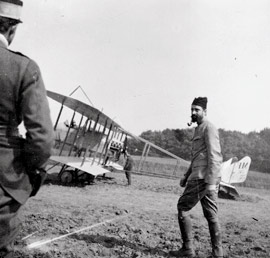
Source : SHD/département Air
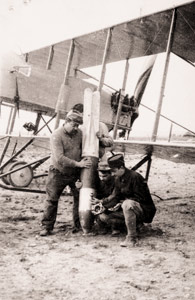
Bombe française fabriquée à partir d'un obus de gros calibre avant d'être montée sur un Farman VII. Source : SHD/département Air
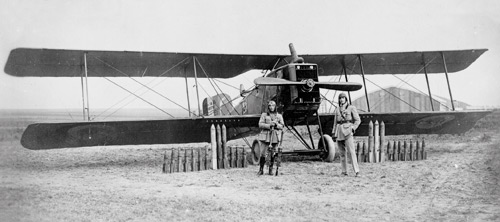
Les frères Peyerimhoff devant un Breguet XIV de l'escadrille BR 123 avec sa panoplie d'armes offensives, des bombes de 50 ou 75 kg et une paire de mitrailleuses Vickers. Source : SHD/département Air
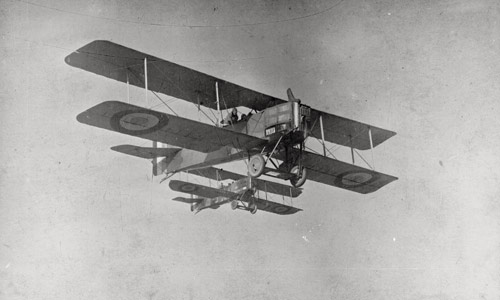
Le Breguet XIV. Source : SHD/département Air
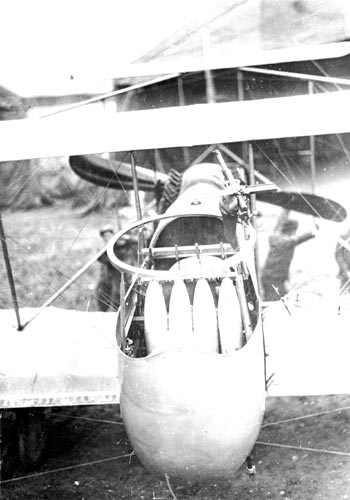
Chargement de bombes sur Farman 40. Source : SHD/département Air




